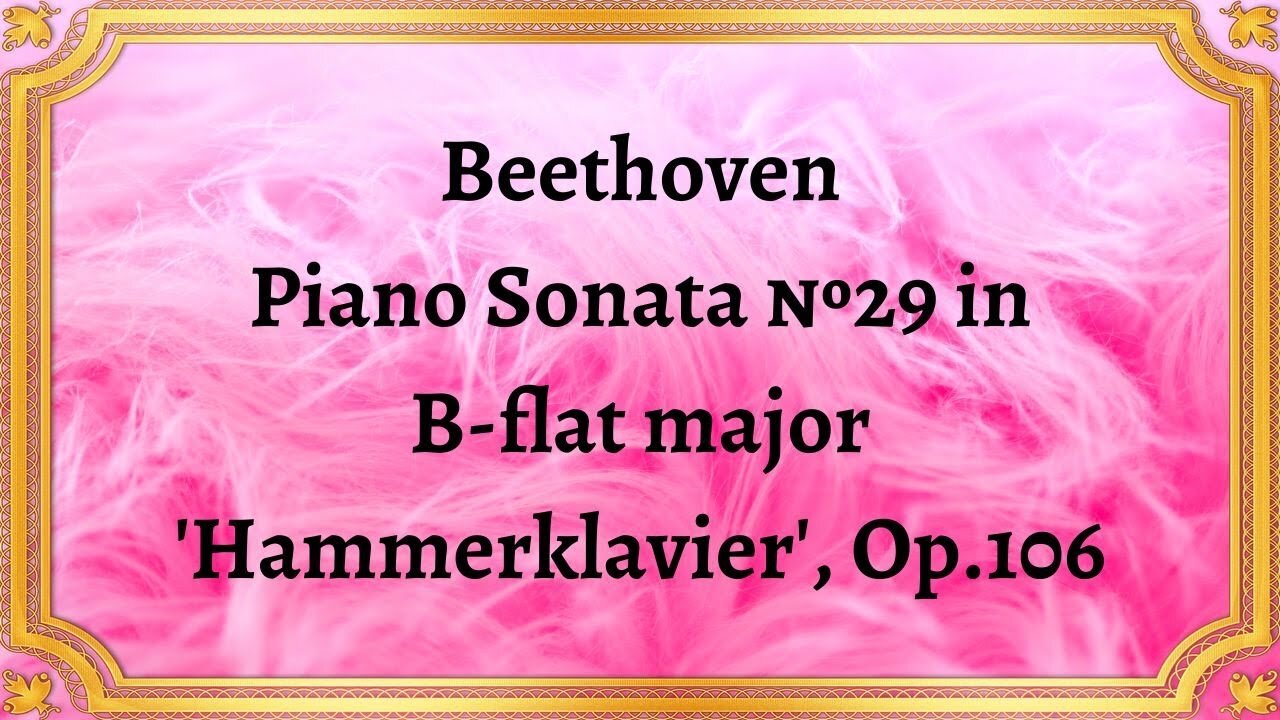Premium Only Content

Beethoven Piano Sonata №29 in B-flat major 'Hammerklavier', Op.106
Beethoven's Piano Sonata No. 29 in B-flat major, Op.106, commonly referred to as the "Hammerklavier," is a monumental work that exemplifies the composer's musical genius and innovation.
Beethoven composed the "Hammerklavier" Sonata between 1817 and 1818, a period marked by personal challenges and creative exploration. This masterpiece emerged during a time when Beethoven's deafness was progressing, leading him to experiment with new musical ideas and push the boundaries of conventional composition. The "Hammerklavier" Sonata stands as a testament to Beethoven's indomitable spirit and unyielding pursuit of artistic excellence.
The "Hammerklavier" Sonata comprises four movements, adhering to the traditional sonata form but expanding it to unprecedented lengths. The first movement is a grand and virtuosic Allegro, followed by a profound and introspective Adagio. The third movement, a monumental Scherzo, provides a contrast of energy and playfulness, while the final movement is a breathtaking fugue that showcases Beethoven's contrapuntal mastery.
The "Hammerklavier" Sonata is renowned for its immense technical demands, pushing the limits of pianistic technique at the time. Beethoven's use of extended range, complex rhythms, rapid passagework, and intricate hand crossings presents formidable challenges to performers, requiring exceptional skill and endurance.
Beethoven's Op.106 Sonata encapsulates a vast emotional range, from moments of transcendent beauty to passages of immense power and intensity. The composer explores contrasting moods, shifting between tender lyricism, dramatic turbulence, and triumphant exaltation. This emotional depth adds to the sonata's lasting impact on listeners.
The "Hammerklavier" Sonata showcases Beethoven's groundbreaking compositional techniques and innovations. From the expanded form and technical demands to the harmonic adventurousness and integration of fugue, Beethoven demonstrates his visionary approach, influencing generations of composers who followed.
Op.106 Sonata represents a turning point in Beethoven's compositional journey. It reflects his tireless exploration of new musical territories, defying conventions and expectations. The sonata's ambition and audacity mark it as a testament to Beethoven's artistic growth and fearless experimentation.
The "Hammerklavier" Sonata stands as one of Beethoven's most significant and revered compositions, captivating audiences and musicians alike. Its grandeur, complexity, and emotional profundity continue to inspire and challenge performers, while its cultural and historical significance make it an enduring symbol of Beethoven's musical legacy.
Beethoven's Piano Sonata No. 29 in B-flat major, Op.106, the "Hammerklavier," is a towering masterpiece that exemplifies the composer's artistic genius and exploration of new musical frontiers. Its vast emotional range, technical challenges, and artistic innovations have solidified its place as one of the most extraordinary works in the piano repertoire. Embark on a musical odyssey with the "Hammerklavier," and immerse yourself in the brilliance and audacity of Beethoven's musical vision.
I. Allegro 00:00
II. Scherzo - Assai vivace 13:14
III. Adagio sostenuto 16:09
IV. Largo. Allegro risoluto 33:25
#classical_music #Beethoven #sonata_for_piano
-
 LIVE
LIVE
cosmicvandenim
5 hours agoCOSMIC VAN DENIM X TRAGIKxGHOST | DEVOUR | Horror Game
95 watching -
 37:36
37:36
Tactical Advisor
3 hours agoOpening Mystery Box & New Thermal | Vault Room Live Stream 036
18K4 -
 1:23:33
1:23:33
Steve-O's Wild Ride! Podcast
2 days ago $12.32 earnedRainn Wilson and Steve-O Break The Silence On Their Long Friendship | Wild Ride #263
26.3K15 -
 42:40
42:40
The Brett Cooper Show
2 days ago $15.81 earnedWhy Are We Attacking Travis Kelce and Theo Von? | Episode 57
39.4K92 -
 58:30
58:30
X22 Report
5 hours agoMr & Mrs X - RFK Jr Begins Banning Poison Foods, Fauci's Lies Unmasked, D’s Lies Exposed - Ep 3
98.9K26 -
 2:59:21
2:59:21
I_Came_With_Fire_Podcast
6 hours agoPakistan Was Laundering USAID Money to Kill Americans
40K18 -
 2:51:15
2:51:15
JuicyJohns
8 hours ago $13.12 earned🟢#1 REBIRTH PLAYER 10.2+ KD🟢CASH CUSTOMS
165K4 -
 42:08
42:08
SouthernbelleReacts
2 days ago $2.65 earned💥 Friday Night Legends | My First Reaction to Varsity Blues (1999) 🏈 Texas Football Drama Unleashed!
41.2K2 -
 LIVE
LIVE
CHiLi XDD
6 hours ago| Tekken 8 | EWC 2025 Watch Party!
122 watching -
 2:28:16
2:28:16
VapinGamers
5 hours ago $1.01 earnedOff the Grid - Controller Scrub Community Games Saturday - !music !rumbot
31.8K